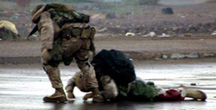Military Trauma


Mechanism of Injury
Military trauma, unfortunately, includes a myriad of injuries, many of which have been addressed in our other areas of technology focus. Mechanical trauma (i.e., cuts, gunshot wounds, crush injuries, etc.), significant increase or decrease in temperatures within the body or outside of the body, shock waves (i.e., thunder), electrical shock, radiation, etc., can all cause cell death by disrupting cell membranes. Soldiers and civilians alike are suffering from tissue loss and even death because their bodies own natural protein chaperone systems that repair damage are easily overwhelmed with such severe trauma. Even with the current methods of surgery and treatment, fatal complications can and do arise. An article published in Military Medicine discusses the seriousness of malignant hyperthermia (MH) on the operating table. Fundamentally, a MH reaction involves severe muscle contracture and heat production that can be fatal if not treated within 10-15 minutes. People who are susceptible to MH can develop the condition due to different triggers, one of them being anesthesia. Currently, dantrolene is being used to arrest the calcium build-up that leads to the muscles contracting, which in turn subverts the body’s heat production. In times of combat, many immediate surgeries are necessary in order to save the lives of our soldiers and innocent civilians. Always pre-screening for MH and having alternative anesthesia on hand that will not trigger this disorder are not practical solutions in such dire situations.
Maroon Biotech's Solution
Maroon’s synthetic surfactant chaperone technology not only has the capacity to repair cell membranes that become damaged through physical and chemical trauma, but it also can halt and reverse cellular damage brought on by MH when used in combination with dantrolene. On its own, dantrolene can only inhibit the metabolic reaction that causes the muscles to become tense and the body to overheat; it cannot heal any of the damage that occurs with such a reaction. So, while the dantrolene therapy has been able to control MH and save many lives, it has not been able to reduce any of the long-term or permanent adverse effects. Over the past 50 years, victims of motor vehicular, burn and military trauma have been surviving at higher rates but living the rest of their lives with permanent disabilities. The next major advance in trauma care must be a method for restoring damaged, non-viable tissue to healthy viable tissue and, in effect, reversing the traumatic injury process and surfactant chaperones are the only therapy capable of accomplishing that therapeutic goal.
